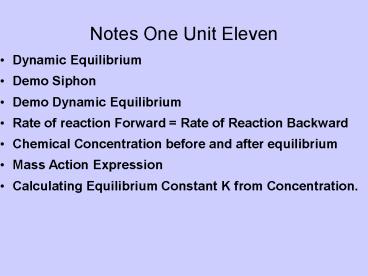Notes One Unit Eleven PowerPoint PPT Presentation
1 / 20
Title: Notes One Unit Eleven
1
Notes One Unit Eleven
- Dynamic Equilibrium
- Demo Siphon
- Demo Dynamic Equilibrium
- Rate of reaction Forward Rate of Reaction
Backward - Chemical Concentration before and after
equilibrium - Mass Action Expression
- Calculating Equilibrium Constant K from
Concentration.
2
Demo Siphon
3
Demo Dynamic Equilibrium
4
Demo Dynamic Equilibrium
5
Dynamic Equilibrium
- Reversible reactions.
- One reaction going forward.
- One reaction going backward.
- Temperature can change the Equilibrium
6
Chemical Concentration before and after
equilibrium
- (a) Only 0.04 M N2O4 present initially
- (b) Only 0.08 M NO2 present initially
7
Mass Action Expression
Mass Action Expressions
d
c
C
D
Keq
b
a
A
B
Solids and liquids are left out
8
Chemical Concentration before and after
equilibrium
NO2
0.0125
0.0125
0.0156
______
2
_______
2
2
_______
_______
2
Keq
N2O4
0.0337
0.0337
0.0522
Experimental Data
Trial Number Initial Concentration Initial Concentration Initial Concentration Initial Concentration Equilibrium Constant
Trial Number N2O4 NO2 N2O4 NO2 NO2 2/N2O4
1
2
3
4
5
0.0000
0.0337
0.0125
4.64x10-3
0.0400
0.0800
0.0337
0.0125
4.64x10-3
0.0000
0.0000
0.0522
0.0156
4.66x10-3
0.0600
0.0600
0.0246
0.0107
4.65x10-3
0.0000
0.0600
0.0429
0.0141
4.63x10-3
0.0200
If the Temperature is the same, K will be the
same.
9
Mass Action Expression
- 4NH3(g) 7O2(g)?4NO2(g) 6H2O(g)
- CaCO3(s)?CaO(s) CO2(g)
- PCl3(l) Cl2(g) ?PCl5 (s)
- H2(g) F2(g) ? 2HF(g)
6
4
NO2
H2O
__________
Keq
4
7
NH3
O2
CO2
Keq
1
____
Keq
Cl2
2
HF
_______
Keq
H2
F2
10
Calculating K
Calculate the Keq at 740C, if CO 0.012 M,
Cl2 0.054 M, and COCl2 0.14 M.
1) Balanced Equation
CO(g) Cl2(g)? COCl2(g)
2) Mass Action Equation
COCl2
________
Keq
CO
Cl2
3) Calculate K
0.14 M1
_________________
220M-1
Keq
Keq
0.012M1
0.054M1
11
Calculating Concentration From K
The equilibrium constant K for the reaction is
158 atm at 1000K. What is the equilibrium
pressure of O2, if the PNO2 0.400 atm and PNO
0.270 atm?
1) Balanced Equation
NO2(g)? NO(g) O2(g)
2
1
2
2) Mass Action Equation
NO
O2
________
2
NO
O2
K
2
2
NO2
x
NO2
K
2
xNO2
2
2
NO2
K
K
3) Solve for O2?
NO2
2
_______
O2
K x
NO
2
4) Calculate K
(0.400atm)
2
_________
O2
(158atm)
347
atm
O2
(0.270atm)
2
12
Notes Two Unit Eleven Chapter Fourteen
- Le Chatelier's Principle
- Silver Chloride Demo
- Calculating K from Initial Conditions
- Calculating Concentration From Ksp
13
Le Chatelier's Principle
- If an external stress is applied, the system
adjusts - An increased stress is reduced.
- A decreased stress is increased.
14
Le Chatelier's Lab
In step 3, hydrochloric acid is used as a source
of Cl-1 ions.
Co(H2O)62(aq) 4Cl-1(aq)? CoCl42(aq) 6H2O(l)
We see more blue!
In step 5, why did adding H2O cause the change
that it did?
Co(H2O)62(aq) 4Cl-1(aq)? CoCl42(aq) 6H2O(l)
We see more red!
In step 6, silver ions from the AgNO3 react with
Cl- ions to produce an insoluble precipitate.
Co(H2O)62(aq) 4Cl-1(aq)? CoCl42(aq) 6H2O(l)
We see more red!
In step 7, acetone has an attraction for H2O.
Co(H2O)62(aq) 4Cl-1(aq)? CoCl42(aq) 6H2O(l)
We see more blue!
15
Writing Solubility Reactions
Ag3PO4 Dissolves
1 cation
1 ion
Ag3PO4 (s)?
Ag1
PO4-3
3
ScF3 Dissolves
1 cation
1 ion
F-1
3
ScF3 (s) ?
Sc3
Sn3P4 Dissolves
1 cation
1 ion
Sn3P4 (s) ?
Sn4
P-3
3
4
16
Silver Chloride Demo
AgCl(s)? Ag1(aq) Cl-1(aq)
NaCl is added
We see a cloudy solidAgCl(s)!
Le Chatelier's Principle!
17
Writing Solubility Reactions
- NaCl Dissolves
- NaCl(s)? Na1 Cl-1
- CaF2 Dissolves
- CaF2(s) ?Ca2 2F-1
18
Calculating Concentration From Ksp
What is the concentration of the cation and
anion for cadmium arsenate,Cd3(AsO4)2, if
Ksp2.210-33 M5?
1) Balanced Equation
AsO4-3(aq)
Cd3(AsO4)2(s) ?
Cd2(aq)
2
3
2) Mass Action Equation
AsO4-3
Cd2
Ksp
2
3
3) What do we know?
0
0
Before Eq
3X
2X
Change
3X
2X
At Eq
4) Calculate X
2X
3X
2
3
2.210-33
108
X5
2.210-33
X1.2x10-7M1
(1/5)
(2.210-33)
Cd2 3(1.2x10-7M )
________
X
AsO4-3 2(1.2x10-7M )
108
19
Calculating Ksp from Concentration
If the molar solubility of BiI3 is 1.32 x 10-5,
find its Ksp.
1) Balanced Equation
BiI3(s) ?
Bi3
I-1
3
2) Mass Action Equation
I-1
Bi3
Ksp
3
3) What do we know?
0
0
Before Eq
X
3X
Change
X
3X
At Eq
4) Calculate Ksp
I-1
Bi3
3
Ksp
3X
X
4
X
27
3
Ksp
(1.32 x 10-5)
27
4
8.20 x 10-19
M4
Ksp
20
Calculating K from Initial Conditions
In a flask 1.50M H2 and 1.50M N2 is allowed to
reach equilibrium. At equilibrium NH3 0.33M.
Calculate K.
1) Balanced Equation
3
2
1
H2(g) N2 (g)? NH3(g)
2) Mass Action Equation
NH3
________
2
K
N2
H2
3
3) What do we know?
H2
N2
NH3
1.50
0
1.50
Before Eq
0.33
-
-
0.50
0.17
Change
1.00
1.33
0.33
At Eq
4) Calculate K
0.33
___________
2
K
0.082
M-2
K
1.00
1.33
3

